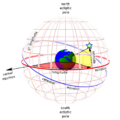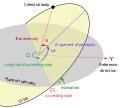The equatorial coordinate system is a celestial coordinate system widely used to specify the positions of celestial objects. It may be implemented in...
17 KB (1,657 words) - 07:37, 20 March 2025
object's location expressed in the equatorial coordinate system can be transformed into the galactic coordinate system. In these equations, α is right ascension...
15 KB (1,383 words) - 10:24, 1 August 2024
In astronomy, the ecliptic coordinate system is a celestial coordinate system commonly used for representing the apparent positions, orbits, and pole orientations...
14 KB (1,331 words) - 02:25, 16 December 2024
position of stars relative to an observer's ideal horizon. The equatorial coordinate system is centered at Earth's center, but fixed relative to the celestial...
29 KB (3,971 words) - 18:25, 17 April 2025
Earth's equatorial region tropical climate the Celestial equator equatorial orbit equatorial coordinate system equatorial mount, of telescopes equatorial bond...
444 bytes (84 words) - 10:11, 21 December 2022
right ascension (α) and declination (δ). This pair based the equatorial coordinate system. While δ is given in degrees (from +90° at the north celestial...
4 KB (391 words) - 14:04, 5 April 2025
A geographic coordinate system (GCS) is a spherical or geodetic coordinate system for measuring and communicating positions directly on Earth as latitude...
23 KB (2,540 words) - 22:18, 14 May 2025
Right ascension (category Astronomical coordinate systems)
specify the location of a point on the celestial sphere in the equatorial coordinate system. An old term, right ascension (Latin: ascensio recta) refers...
14 KB (1,371 words) - 01:10, 25 October 2024
is a Cartesian coordinate system (x, y, z). The equatorial coordinate system uses the celestial equator. The ecliptic coordinate system uses the ecliptic...
2 KB (178 words) - 15:13, 9 January 2025
A near-equatorial orbit is an orbit that lies close to the equatorial plane of the primary body orbited. Such an orbit has an inclination near 0°. On Earth...
5 KB (689 words) - 18:00, 15 March 2025
Equatorial Coordinate System), the direction cosine vector of the orbiting body from the observation points (from Topocentric Equatorial Coordinate System)...
15 KB (2,829 words) - 06:02, 6 February 2025
astronomy are celestial coordinate systems and time. The coordinates of objects on the sky are listed using the equatorial coordinate system, which is based on...
6 KB (662 words) - 17:07, 22 October 2023
In mathematics, the polar coordinate system specifies a given point in a plane by using a distance and an angle as its two coordinates. These are the...
49 KB (6,702 words) - 21:47, 13 May 2025
The horizontal coordinate system is a celestial coordinate system that uses the observer's local horizon as the fundamental plane to define two angles...
9 KB (944 words) - 04:39, 7 January 2025
The supergalactic coordinate system is a reference frame for the supercluster of galaxies that contains the Milky Way galaxy, referenced to a local relatively...
7 KB (927 words) - 03:24, 17 July 2024
The perifocal coordinate (PQW) system is a frame of reference for an orbit. The frame is centered at the focus of the orbit, i.e. the celestial body about...
6 KB (1,037 words) - 03:50, 27 January 2025
Declination (category Astronomical coordinate systems)
two angles that locate a point on the celestial sphere in the equatorial coordinate system, the other being hour angle. The declination angle is measured...
12 KB (1,187 words) - 11:39, 18 February 2025
Celestial equator (redirect from Equatorial plane)
Earth. By extension, it is also a plane of reference in the equatorial coordinate system. Due to Earth's axial tilt, the celestial equator is currently...
5 KB (423 words) - 12:52, 5 June 2025
An areostationary orbit, areosynchronous equatorial orbit (AEO), or Mars geostationary orbit is a circular areosynchronous orbit (ASO) approximately 17...
8 KB (794 words) - 23:21, 6 June 2025
is an event, defined only when using either an equatorial or an ecliptic celestial coordinate system, in which any two astronomical objects (e.g. asteroids...
25 KB (144 words) - 00:30, 7 December 2024
ISBN 0-7506-6169-0. Retrieved 2023-01-08. Xu, Guochang; Xu, Yan (2016). "Coordinate and Time Systems". GPS. pp. 17–36. doi:10.1007/978-3-662-50367-6_2. ISBN 978-3-662-50365-2...
6 KB (833 words) - 11:13, 26 March 2025
A planetary coordinate system (also referred to as planetographic, planetodetic, or planetocentric) is a generalization of the geographic, geodetic, and...
19 KB (2,166 words) - 18:42, 29 March 2025
Orbital mechanics Astronomical coordinate systems Characteristic energy Escape velocity Ephemeris Equatorial coordinate system Ground track Hill sphere Interplanetary...
9 KB (1,039 words) - 13:01, 7 June 2025
orbit. However, a synchronous orbit need not be equatorial; nor circular. A body in a non-equatorial synchronous orbit will appear to oscillate north...
8 KB (813 words) - 03:33, 1 June 2025
Low Earth orbit (redirect from Equatorial Low Earth Orbit)
altitudes below 300 km (190 mi) decay quickly due to atmospheric drag. Equatorial low Earth orbits (ELEO) are a subset of LEO. These orbits, with low orbital...
19 KB (2,128 words) - 23:59, 8 June 2025
Hour angle (category Astronomical coordinate systems)
specify the location of a point on the celestial sphere in the equatorial coordinate system. The local hour angle (LHA) of an object in the observer's sky...
6 KB (676 words) - 15:20, 16 April 2025
(astronomy), an astronomical term associated with the celestial equatorial coordinate system Σ(α, δ)ellipse and lower, a hyperbola Polar distance (geometry)...
585 bytes (102 words) - 02:08, 5 July 2014
systems design and implementation with a view to maximising service Hour angle, in astronomy, one of the coordinates of the equatorial coordinate system...
4 KB (441 words) - 21:24, 26 April 2025
eccentricity vector (a vector pointing towards the periapsis). In the case of equatorial orbits (which have no ascending node), the argument is strictly undefined...
4 KB (565 words) - 00:23, 24 September 2024
telescope equipped with a properly aligned equatorial mount, the observer may also follow the equatorial coordinate system on a star map to move along the lines...
4 KB (473 words) - 09:32, 2 June 2025



















